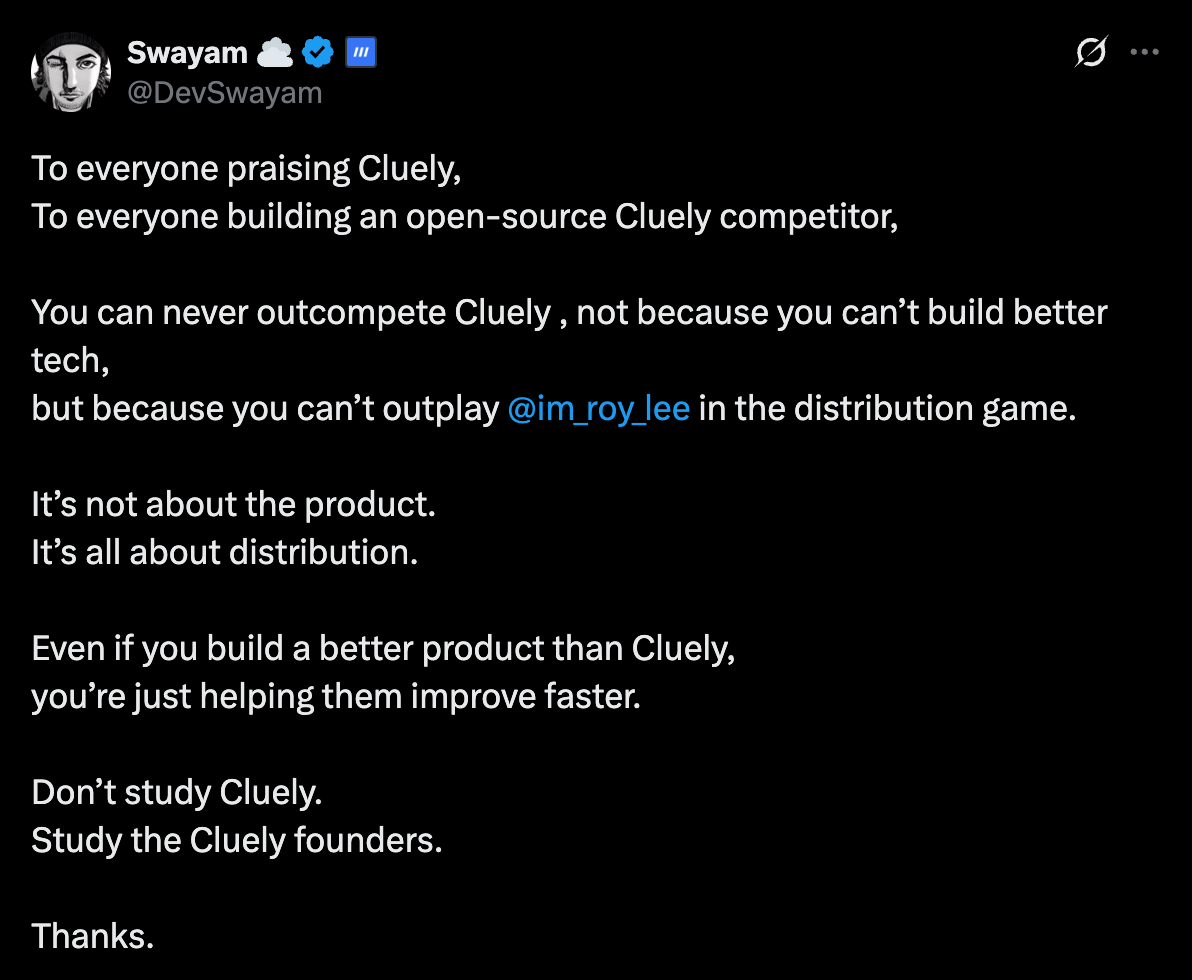Cluely Nailed their Launch — But for the Wrong User
Their software to cheat on interviews went viral. Now what?
Cluely has exploded onto the startup scene with a provocative pitch: an AI assistant that helps you “cheat on everything.” That tagline was core to the product, embedded in the founder’s origin story, and echoed in every piece of content they shipped.
If you missed the headlines: Cluely is a transparent overlay that sits on your computer, watching and listening to everything on your screen. It feeds you real-time suggestions to “think for you”—whether in interviews, meetings, lectures, or sales calls.
Here’s the short version of how Cluely became one of the most talked-about AI startups of 2025:
The founder, Roy Lee, was kicked out of Columbia after using an earlier version of Cluely (then Interview Coder) to cheat on a technical interview—and get a job at Amazon.
He shared his story in a viral X thread. Silicon Valley responded with millions in funding.
A $5.3M seed round came first, then a $15M Series A led by Andreessen Horowitz.
Their launch content followed the same playbook: cinematic-quality viral videos. A cheeky video showed Lee using Cluely to fake his way through a date.
…followed by them releasing more viral-style content: see their funding announcement video.
Rinse & repeat.
And now? They’re hiring 50 “Growth Interns,” each tasked with creating 4 TikToks per day.
Cluely is writing a new playbook for the modern startup launch.
✅ Founder-led virality
✅ Controversy as a growth strategy
✅ Low-burn, high-margin software (they’re reportedly already profitable)
✅ Simple product narrative that fits neatly into an X post preview
They deserve real credit—this was a sharp and deliberate execution of a “distribution-first” strategy. Congrats to their entire team.
But here’s the catch: they may have nailed the launch…but for the wrong user.
The B2C Trap
Edgy videos. Tongue-in-cheek demos. A feed built for clicks.
Cluely’s mastered a launch strategy built for a B2C product.
Their product that has also solved a real technical problem: voice transcription latency.
If you strip away the viral marketing, the core product is an always-on, always-there overlay that transcribes speech at the speed of thought & gives you helpful hints.
The best use cases for Cluely’s product could actually be, well, not cheating. The core product could actually be more valuable to B2B, enterprise, and institutional clients.
Enterprise sales teams could use Cluely for product knowledge during live sales calls. (they’ve already clued in on this use case, no pun intended! 🔎)
Therapists could use Cluely for follow-up questions and to suggest next steps.
Doctors could use it for patient interviews and accurate diagnoses.
Lawyers could leverage it to stay organized and thorough in discovery meetings.
Financial advisors could ensure they’re providing the best advice to their clients.
To be clear, the consumer path isn’t wrong—it’s just a lot more fragile for building a SaaS product.
Virality can look like traction, but churn in B2C subscription products is high, ARR is unstable, switching costs are near 0, and users are fickle.
Compare that with B2B: sales cycles take longer, but vendors achieve lock-in through solid relationships and performance. For this reason, B2B ARR tends to be more stable.
But here’s the thing: trust is the currency of B2B sales.
And building a brand on cheating ≠ trust.
Cheating ≠ Trust
To their credit, the Cluely team seems to be picking up on this shift, at least on their landing page. They’ve already removed “undetectable AI assistance for every interview” from their website and are leaning into productivity messaging—deep work, sales enablement, learning, and meetings.
But on social, the “cheat on everything” DNA is alive and well.
Their recent X post lists use cases like:
Cheat on meetings
Cheat on customer support
Cheat on user interviews
Cheat on recruiting
Cheat on sales
Even if the word “cheat” is a metaphor, will that word resonate with enterprise buyers?
You can’t sell “cheatware” to a CIO.
And for B2B buyers, trust is everything.
Are Distribution and Speed a Moat?
Open-source competitors have already emerged with similar capabilities. (Side bar: the competitors are replicating the liquid glass overlay, but the real product innovation is in the real-time voice-to-text transcription combined with the always-there overlay.)
The underlying product, as with most products in the vibe coding era, is replicable.
Folks on X, like @DevSwayam argue that Cluely’s distribution is the moat. A recent Andreesen Horowitz blog boldly states momentum is the moat.
That’s why the Cluely team is betting on growth and distribution as a moat: the Growth Intern TikTok army, the theatrical-style funding announcement videos, the party-that-got-shut-down-by-the-police lore.
But virality ≠ defensibility. And attention ≠ adoption.
Right now, Cluely is building the product around exposure, but exposure can fade.
In contrast, B2B moats compound:
Deep integration into enterprise workflows
Internal champions and process transformation
Long-term contracts
Trusted relationships
B2B relationships are slower to build. You can’t build them with memes or viral videos. But they are far more durable.
If Cluely stays focussed on B2C, it’s competing in a market where churn is high and switching costs are low. If it pivots to B2B, it must overcome the brand baggage of “cheat on everything”.
Final Thoughts
Cluely is one of the most compelling case studies in how to launch in 2025:
✅ Bold founder.
✅ Clear story.
✅ Speed-to-market.
✅ Social media mastery.
But distribution and momentum are only half the battle.
The harder part? Choosing the right customers and use cases to commit to.
B2C vs. B2B. Industry verticals. Workflows.
Product-market fit isn’t just what you build. It’s about who you build for, and how you earn their trust.
💬 What’s your take on Cluely’s launch strategy, and where they go from here?
P.S. Love diving deep into product stories? Support my work by shopping the collection at Post MVP.






